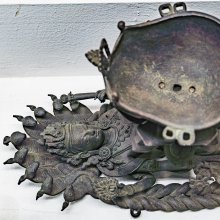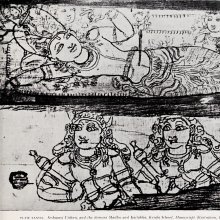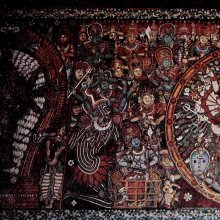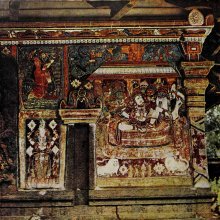Sheshashayi, Śeṣaśāyi, Śeṣaśāyī, Shesha-shayi: 3 definitions
Introduction:
Sheshashayi means something in Hinduism, Sanskrit, Tamil. If you want to know the exact meaning, history, etymology or English translation of this term then check out the descriptions on this page. Add your comment or reference to a book if you want to contribute to this summary article.
The Sanskrit terms Śeṣaśāyi and Śeṣaśāyī can be transliterated into English as Sesasayi or Sheshashayi, using the IAST transliteration scheme (?).
Images (photo gallery)
In Hinduism
Vastushastra (architecture)
Source: Shodhganga: Temples of Salem region Up to 1336 ADŚeṣaśāyi (शेषशायि).—The Śeṣaśāyi rock-cut shrine has been built in an elevated place and has a flight of steps leading to the shrine. In between the hastihastas of the sopānas, there is a figure of a squatting yakṣa, which is locally referred to as ‘Viśvakarmā’. Originally, the rock-cut shrine had an open porch with four pillars in a row. A modern wall has been built between the pillars. This porch is about four feet wide and is narrow. The porch leads to an elevated platform which is about three feet high. The platform possesses a pādabandha-adhiṣṭhāna.
Āyudhas are represented in human forms. Reliefs of sages and celestials have been carved around the Śeṣaśāyi sculpture. Two huge sculptures of the demons, Madhu and Kaiṭabha are carved near the feet of main deity. On either sides of the wall the sculptures of Sūrya and Candra are carved. This sculpture belong to the uttamaśayanamūrti class.
On the two walls of the porch, the sculptures of Harihara and Trivikrama are carved. In the Trivikrama panel, Trivikrama stands on his left leg and the right leg is raised towards the heavens. The Harihara sculpture is standing in samabhanga. The right half, which depicts ‘Hara’, holds two Serpents in both the hands. The left half depicting Viṣṇu holds a conch in the upper hand and the lower hand is in kaṭihastamudra.

Vastushastra (वास्तुशास्त्र, vāstuśāstra) refers to the ancient Indian science (shastra) of architecture (vastu), dealing with topics such architecture, sculpture, town-building, fort building and various other constructions. Vastu also deals with the philosophy of the architectural relation with the cosmic universe.
Languages of India and abroad
Kannada-English dictionary
Source: Alar: Kannada-English corpusŚēṣaśāyi (ಶೇಷಶಾಯಿ):—[noun] = ಶೇಷಶಯನ [sheshashayana].
Kannada is a Dravidian language (as opposed to the Indo-European language family) mainly spoken in the southwestern region of India.
Tamil dictionary
Source: DDSA: University of Madras: Tamil LexiconŚēṣaśāyi (ஶேஷஶாயி) [śēṣa-śāyi] noun < Śēṣa-śāyin. Viṣṇu, as recumbent on the serpent Śēṣa. See சேஷசாயி. [seshasayi.]
Tamil is an ancient language of India from the Dravidian family spoken by roughly 250 million people mainly in southern India and Sri Lanka.
See also (Relevant definitions)
Partial matches: Shesha, Sayin, Cayi.
Starts with: Sheshashayin.
Full-text: Sheshshayi, Barevaraditya, Karnadevi, Nakiraja, Arhaddeva, Campakambike, Kavarasa, Nakarasa, Bhillarasa, Nimbarasa, Nimbadeva, Sayanamurti, Surya, Kulacandra, Maghanandi.
Relevant text
Search found 7 books and stories containing Sheshashayi, Śeṣaśāyi, Śeṣaśāyī, Shesha-shayi, Sesasayi, Śeṣa-śāyī, Śeṣa-śāyi, Sesa-sayi, Śēṣaśāyi, Śeṣaśayi, Śeṣa-śayi, Śēṣa-śāyi, Sheshashaayi, Shaeshashaayi; (plurals include: Sheshashayis, Śeṣaśāyis, Śeṣaśāyīs, shayis, Sesasayis, śāyīs, śāyis, sayis, Śēṣaśāyis, Śeṣaśayis, śayis, Sheshashaayis, Shaeshashaayis). You can also click to the full overview containing English textual excerpts. Below are direct links for the most relevant articles:
Garga Samhita (English) (by Danavir Goswami)
Verse 4.1.5 < [Chapter 1 - The Story of the Personified Vedas]
Chaitanya Bhagavata (by Bhumipati Dāsa)
Verse 3.9.231 < [Chapter 9 - The Glories of Advaita]
Srila Gurudeva (The Supreme Treasure) (by Swami Bhaktivedanta Madhava Maharaja)
Śrīla Swāmī Mahārāja’s Final Order < [Chapter 2.8 - Our Lasting Relationship]
Residing in Śrī Keśavajī Gauḍīya Maṭha < [Chapter 2.7 - Śrīla Gurudeva and Śrīla Bhaktivedānta Swāmī Mahārāja]
Accepting Sannyāsa < [Chapter 2.7 - Śrīla Gurudeva and Śrīla Bhaktivedānta Swāmī Mahārāja]
The Skanda Purana (by G. V. Tagare)
Chapter 65 - The Greatness of Nāga Tīrtha < [Section 1 - Avantīkṣetra-māhātmya]
Chapter 70 - Index of All Tīrthas (in this Text) < [Section 1 - Avantīkṣetra-māhātmya]
Chapter 29 - Gaṅgā-Sahasranāma (A Thousand Names of Gaṅgā) < [Section 1 - Pūrvārdha]
The Shiva Purana (by J. L. Shastri)
Chapter 13 - The creation of Brahmā and Viṣṇu < [Section 7.1 - Vāyavīya-saṃhitā (1)]
Chapter 16 - The battle of the gods < [Section 2.5 - Rudra-saṃhitā (5): Yuddha-khaṇḍa]
The Linga Purana (by J. L. Shastri)
Chapter 17 - Origin of the Liṅga (liṅgodbhava) < [Section 1 - Uttarabhāga]



